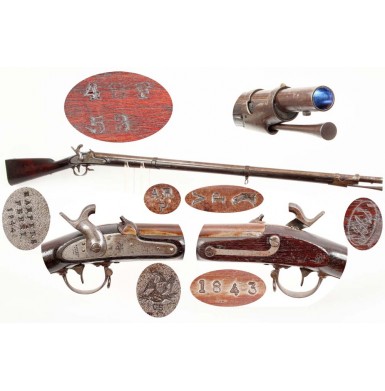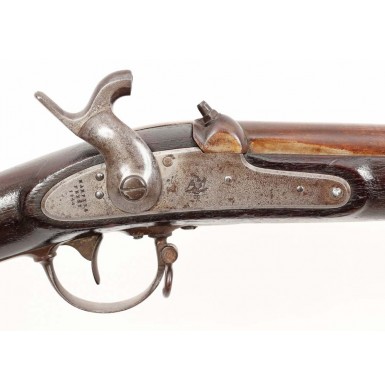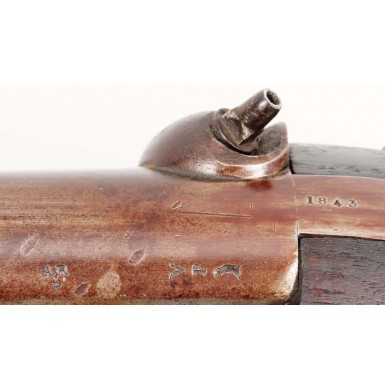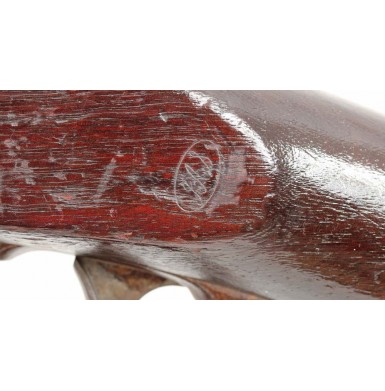The US M-1842 percussion infantry musket represented a major advancement in the production of US military small arms during the mid-19th century. The M-1842 was the first general issue US military long arm to utilize the percussion ignition system and was also the first general issue arm to be manufactured on the principle of fully interchangeable parts at both US arsenals. While the percussion ignition system had been introduced to the US military with the M-1833 Hall-North Carbine and a few years later with the M-1841 “Mississippi” Rifle, these arms were not widely issued and were reserved for specialty troops and state militia use. Likewise, the Harper’s Ferry produced M-1819 Hall Rifle had been manufactured on the interchangeable parts principle since its introduction, but it was also a long gun that would see limited issuance and use, when compared to the infantry musket. The M-1842 also had the distinction of the being the last general issue .69 caliber smoothbore weapon to be manufactured and issued to the US military, and was superseded by the .58 caliber M-1855 rifle muskets. The design that would become the M-1842 musket was initiated at the end of 1841, when the Chief of Ordnance requested that sample arms be forwarded for to the Ordnance Board for approval. The specification was simply that the current M-1840 flintlock musket be redesigned as a percussion ignition weapon, with as few changes as possible, in order to make the transition to production of the new musket as simple and quickly as possible. The US M-1842 percussion musket went into production at the Springfield Arsenal in 1844; with 2,956 completed guns being delivered into stores that fiscal year (July 1, 1843-June 30, 1844). Production did not commence at Harper’s Ferry until 1845, and that armory delivered 2,225 arms into store during fiscal year 1845 (July 1, 1844 to June 30, 1845). Even though completed muskets were not delivered into the storekeepers inventory until the dates noted above, the manufactured of parts commenced prior to delivery of completed arms, in some cases as much as year prior to any deliveries. The locks and barrels of the guns were also dated based upon the annual calendar (January 1 “ December 31) rather than the fiscal accounting calendar that ran from July 1 to June 30 of the next year. Thus a gun completed in the second half of calendar year 1844 (after July 1 of 1844) would show up as “delivered” in 1845, as fiscal year 1845 began on July 1 of 1844. The M-1842 muskets remained in production until 1855, with Springfield Armory producing 165,970 and Harpers Ferry producing 106,629, making the total production for the M-1842 musket 272,599. The M-1842 musket saw significant use during the American Civil War and as late at the summer of 1864, a significant number (at least 25,000) were still in the field with US forces, and a similar (or possibly large number) were almost certainly still in service with the Confederacy. The fact that the US M-1842 remained in service with the US government well into the war is underscored by the fact that government was forced to make inquiries with contractors to provide spare parts, ramrods and bayonets for the guns during 1864. As late as the 2nd quarter of 1864 the Ordnance Department was still attempting to obtain the necessary parts to keep the M-1842 muskets that were in the field in serviceable condition. The ever-frugal US government kept thousands of US M-1842 muskets in government stores until 1870, when they began to sell of the arms via auction.
This US M-1842 Percussion Musket is in about FINE condition. The US arsenal at Harper’s Ferry manufactured the musket and it was certainly one of the first guns delivered during fiscal year 1845, probably being delivered during the summer of 1844. The gun bears the extremely early dates of 1844 on the lock, and the even earlier date of 1843 on the barrel, making it one of the first percussion musket barrels to be manufactured at Harper’s Ferry for M-1842 production. Harper’s Ferry records do not record any M-1842 muskets being delivered during fiscal year 1844 (July 1, 1843-June 30, 1844), but does show 2,225 M-1842s being delivered during fiscal year 1845 (July 1, 1844-June 30, 1845). This gun must have been one of those very first 2,225 muskets. The musket is clearly and crisply marked in three vertical lines behind the hammer: HARPERS / FERRY/ 1844. The usual US (EAGLE) / US is marked on the lock, forward of the hammer. According to arms historian and author George Moller, it appears that some of the M-1842s manufactured during 1844 and early 1845 had color case hardened locks. The lock of this musket does not retain any significant signs of case coloring. The lock has a dull pewter gray appearance, with some light surface oxidation and pinpricking, along with scattered dark brown and black age discoloration. The lock is mechanically perfect and it functions very crisply on all positions. All of the markings on the lock are crisp and clear and are quite legible. The breech of the musket is crisply marked with the usual V / P / (Eagle Head) proof and inspection marks, and the barrel tang is crisply stamped with the date 1843. As the gun was manufactured at Harper’s Ferry it also bears the additional Harper’s Ferry inspection mark of AR / P. This is the mark of Adam Ruhlman who was a long time Harper’s Ferry arms inspector and who proved many barrels at that arsenal. The barrel of the musket has beautiful, untouched smooth, chocolate brown patina that is somewhat thinner in some areas and slightly thicker in others. The patina is so smooth and attractive that is almost looks like the barrel was browned at one point in time, but moving the barrel bands reveals the dull pewter color of the metal that has not oxidized like the majority of the barrel that was exposed to air, and possibly smoke. The barrel is completely smooth and essentially free of any pitting with only some light pinpricking present around the bolster and very lightly scattered along the barrel. The middle and rear barrel bands have a slightly thicker, darker brown patina, while the upper band shows a thinner, more mottled patina exactly the same color as the barrel. The muzzle area shows some areas where the patina is thinner or worn, suggesting that a bayonet was displayed on the gun for some period of time. The balance of the iron furniture shows the same attractive chocolate brown patina as the barrel and matches the rest of the gun perfectly. The bore of the musket is mostly bright and very smooth, and rates about FINE overall. The bore shows some lightly scattered pinpricking along its length a couple of rings of light pitting and oxidation about 3”-4” from the muzzle. It is not clear if this is just some old debris that could be brushed out easily or if it is really light pitting in that area. The rings are minor and in no way affect the quality of the bore or its potential to be a good shooting musket. The tang of the buttplate is marked with usual US, which is crisply and deeply struck. The buttplate shows some pinpricking and scattered pitting over its surfaces. The musket retains both of the original sling swivels and its original trumpet head ramrod, which is full-length and has perfect threads on the end. The stock of the musket is in very nice condition and rates about FINE as well. The stock is fairly crisp and retains good edges and lines throughout. The stock is full-length and solid with no breaks, cracks or repairs noted. The stock does show a handful of minor bumps and dings from use, handling, and storage, but absolutely no abuse of any kind or anything excessive for a 171-year-old military musket. The wood to metal fit is very nice throughout and shows the expected quality workmanship of Harper’s Ferry. The stock flat, opposite the lock, is crisply and deeply marked the very legible script JAS cartouche. This is the mark of Harper’s Ferry sub-inspector James A Schaeffer. The obverse buttstock of the musket is also clearly unit marked with the two line rack number: 48 F / 53. This suggests 48th Infantry, Company F, Man #53. Only 7 Confederate (AL, GA, MS, NC, TNx2 & VA) and 11 Union regiments (IA, IL, IN, KY, MA, MO, NY, OH, PA, USCT & WI) bore the designation 48th infantry, and with a little bit of detective work, you might be able to determine which 48th regiment this musket was issued to. You can rule out the 48th Illinois Infantry, as their ordnance returns reveal they spent their service armed with .577/.58 rifled muskets. That only leaves 10 US regiments and the 7 Confederate regiments to go through. The stock does not appear to have been sanded at any time, but does seem to have been lightly oiled at some point and also protected with a thin coat of old varnish. It will be up to the new owner whether or not they want to strip that varnish or leave it in place, as it has certainly helped to protect the stock from damage over the passing years.
Overall this is a really nice example of a very early production US M-1842 musket from the famous Harper’s Ferry arsenal. The gun remains crisp and sharp throughout strong markings in both the metal and the wood. It is really amazing that a 171-year-old military musket has survived in this condition. The gun was produced during the first year of actual production at the Harper’s Ferry Armory, and is one of only 2,225 delivered into stores during that fiscal year. The musket has the very desirable, pre-Mexican War production date of 1844. For any serious collector of Harper’s Ferry long arms, this first year of production US M-1842 is a “must have” example, and with so few delivered during fiscal year 1845, it is not likely another one will pop up for sale any time soon. The nice unit marking in the buttstock may allow the new owner to not only determine what regiment the musket was issued to, but possibly which solider in that regiment, as the rosters will probably show who man #53 of Company F was. The research would certainly be fun and could easily increase the value of the musket 2 to 3 fold if the identification is concrete.
SOLD







